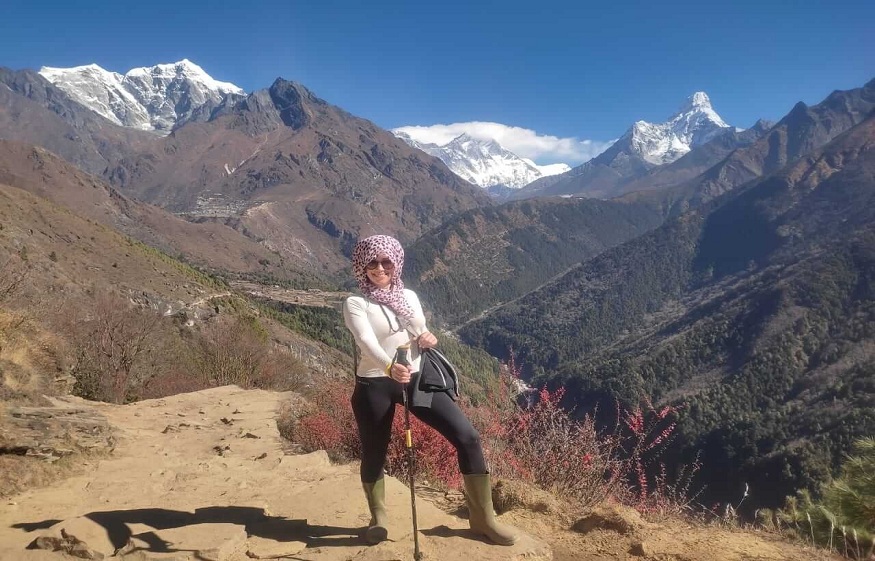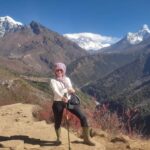
How to Prepare for the Everest Base Camp Trek: Expert Tips & Advice
Trekking to Everest Base Camp (EBC) takes quite a lot, but despite its intensity, with meticulous preparation and commitment, it can be a dream of a lifetime. For adventure seekers wanting to hike to one of the highest places that are hikeable, proper preparation is the key to a safe and successful adventure. The trek is doable for most people, but you do need to be physically and mentally prepared for it (and have the right gear).
Mount Everest Base Camp Trek The first part of the preparation is a state of fitness. Note: You do not need to be an elite athlete to do the EBC trek, but a minimum level of fitness is key. Work on your aerobic conditioning with activities such as hiking, running, walking, or biking. Training hikes with a backpack on rough ground will best mimic the conditions of the trek. You do need to build strength in your legs as you will be walking over steep ascents and descents, which can take a toll on your leg muscles. Core strength exercises can also help stabilize your body and replace fatigue with power. Get out there and work on hill training to mitigate the constant change in elevation along the trek.
High altitudes need acclimatization to a large extent. The EBC trek takes you to altitudes higher than 5,000 meters above sea level, where the oxygen levels are low. If not addressed properly, it can also lead to altitude sickness. Strategic rest days at critical points of the trek are key to helping your body acclimate. Following the “climb high, sleep low” principle — where you hike up to a higher elevation during the day but return to a lower altitude to rest overnight — minimizes the risk of altitude sickness. Hydration, nutritious meals, and avoidance of alcohol and smoking all play key roles in the prevention of altitude-related problems.
Physical readiness is important, but the mental factor can contribute to your success. The EBC hike is long, challenging, and mentally taxing. Being ready for the mental aspects of hiking (hours of walking each day as well as potential discomfort) is key. Having a good outlook on what it is you are doing and then reminding yourself of what made you start the trek in the get-go will help you through the challenging times.
Select the right clothing and gear when it comes to packing. The weather can shift at a moment’s notice, so layered pieces are essential. a moisture-wicking base layer, an insulating layer, and a weatherproof outer layer. Trekking boots are a must for support and comfort on rough terrain — so spring for a decent pair. What to bring? A sleeping bag rated for sub-zero temperatures, since nights at altitude can be very cold. Pack light, but pack wisely: only take what you need and avoid dragging along pounds you don’t need.
Finally, it’s worth thinking practically about the logistics of your trek. You must obtain permits like the TIMS (Trekkers’ Information Management System) and the Sagarmatha National Park permit. You can get these in Kathmandu before the trek. Also part of the planning is booking a flight to Lukla, where the trek begins. Flights to Lukla are small and rely heavily on the weather conditions, so you should be ready for flight delays or cancellations.
Decide if you want to hire a guide or a porter. The EBC trek is also known to be well-marked, however, a guide can really help guide you through the terrain, help in emergencies, and share local knowledge. A porter can carry your heavier gear so you can focus on the trek itself.
With these insider tips and some serious prep time, you can take on the Everest Base Camp trek with confidence and excitement. Throughout your journey, you will be one step closer to the grand prize: gazing up at the mountain from the foot of Mount Everest with some of the most stunning sights of the highest mountains in the world.
Budgeting for Your Trip: All You Need to Know
A significant step towards a smooth and stress-free plan to trek to Everest Base Camp is planning your budget. The trek can be expensive or cheap, depending on the choices you make, such as whether you trek independently or in a guided group. A solo trek will likely cost around $ 800- USD 1,200 on average, between permits, flights to the nearest city, accommodation, and meals. Hiring a guide or porter will hike the price, with guided treks generally costing between $1,500 and USD 3,000 per person, according to the company and what services are provided.
Essential budget considerations include flights to Kathmandu (roughly $400-USD 600 from the U.S.), domestic flights to Lukla (around $150-USD 200), permits (around $50-USD 100), accommodations (typically $5-USD 10 in teahouses per night), meals (roughly $15-USD 20 per day), and gear rental or purchase.
You will also need to factor in emergency expenses for helicopter evacuation, or a delay if the weather turns, meaning travel insurance is a must. Finally, make sure to bring cash in the form of Nepali rupees, as ATMs aren’t always available on the trail. Your travel budget will come in handy to give you a rough idea of what to expect about expenses and to prepare yourself accordingly for your journey.
When to Trek Guided, Portered, or Solo
Everest Base Camp One of the biggest choices you have to make when planning your Everest Base Camp trek is whether to attempt the trek independently or use a guide and/or porter. Each option has known advantages and challenges, and your decision will depend on your experience, preferences, and budget.
Guided treks are perfect for first-time trekkers or for those who would prefer additional support and local knowledge. It’s safer to have a guide who understands the culture and environment and can navigate for you. Most are seasoned guides and can adapt to the unexpected. Guided treks are typically pricier, however, and while guide fees range from$20 to $30 per day, the overall cost climbs fast.
A porter can hold your heavy rucksack so you can concentrate on the hike. This is ideal for hard workers who prefer to lighten their loads and eliminate the strain of a heavy pack for a trip or two. Porters earn an average of $15 to $20 per day, and it’s common to tip at the end of a trek.
On the flip side, solo trekking costs less and is a more liberated experience. But it also has risks, including challenges with navigation, safety, and the complication of medical emergencies. These are things that a first trekker would need to face, and one of the reasons I wouldn’t recommend solo trekking unless you are sure you will be able to face the conditions.
HEALTH AND SAFETY Get Your Trail Safety Gear
Ensuring your health and safety should be top of the checklist when setting off on your Everest Base Camp trek. The rugged terrain, humidifier altitudes, and volatile weather can be revealingly challenging, so it’s extremely to be well-planned and cautious.
High altitude sickness is the biggest threat to health and manifests with nausea, dizziness, and a headache. To prevent altitude sickness, gradually acclimatize according to the “climb high, sleep low” principle and the need to take supplementary rest days, if deemed necessary. Drink lots of water, eat energy-rich meals, and skip alcohol.
And pack a full first-aid kit — an assortment of medications including pain relievers, bandages, blister treaters, and personal medications you might need. Know how to treat common injuries or illnesses, and when to seek medical attention.
Himalayan Base Camp Trek In the Himalayas, the weather can be brutal, with the temperature dropping well into sub-zero at high altitudes. It is vital to invest in adequate clothing and gear, including a quality sleeping bag, a water-resistant jacket, and thermal layers. Be on the lookout for signs of fatigue, and don’t force your body to go past its limits.
Travel insurance is essential for coverage against unexpected emergencies such as injury, evacuation, and surprise trip cancellations. Travel medical and evacuation coverage will give you peace of mind when things don’t go as planned.
Expect the Unexpected: Weather Delays
Everest Base Camp Trek Flight delays are common in the Everest region because the weather in the Everest region isn’t predictable, and flights can be canceled because of snowstorms or other circumstances. Having the mental and practical mindset for uncertainty is an integral component of your trek preparation.
The weather depends on the season, as it could be monsoon rains from June to September, and freezing temperatures from October to February. Spring (March to May) and autumn (September to November) are the best trekking seasons for more stable weather, though conditions can still shift quickly.
It is often because of the weather, and flights into and out of Lukla are often delayed, especially during the winter months when fog or snow prevents planes from landing. Always allow extra time before and after your trek for potential delays.
Be prepared that trail conditions might be impacted by rain or snow, which can cause mudslides, slippery trails, or closures. Consider that unexpected things can result in additional time on the trail, which means you’ll need more food, lodging, and gear.
To counter this, pack more snacks than you think you might need, maintain flexible plans, and build in some extra rest days. Keep in contact with your trekking agency or guide to get updated weather forecasts and to be ready for abrupt changes.
How to Prep for the Everest Base Camp Trek?
Everest Base Camp Trek (EBC) is a once-in-a-lifetime trip and, as such, requires careful preparation physically and psychologically. Preparing for success involves knowing the requirements of the trek, plotting your course, and making arrangements for everything from permits and gear to budgeting and health measures.
Train for endurance, strength, and stamina, as having the right physical fitness will set you up to ensure that you are the dominant party in a lethal encounter. Mental resilience is just as vital; maintaining motivation through long, arduous days is essential to success.
Everest Base Camps Acclimatization is key — give your body time to adapt to the higher altitudes with rest days and gradual ascents. Know weather conditions and plan for delays, making flexibility a planned part of the trip.
For novices, opt for a guided, portered trek or one with full service; for those more experienced, trek solo, knowing that safety is always the priority. Have the proper permits as well as all necessary gear, such as a first-aid kit, Personal medications, and clothing for changing weather conditions.
With every aspect of your trek prepared for, you can completely settle in to enjoy the spectacular scenery and stunning vistas available at Everest Base Camp. Be well-prepared, and your journey will be arduous yet uniquely rewarding.
What is the Best Way to Go to Everest Base Camp?
Here are some key points to prepare yourself for the Everest Base Camp trek. Begin with some physical fitness—a combination of cardio (running, cycling) and strength training (leg workouts, core routines) to deal with long days of trekking and steep ascents. Acclimatization is crucial, so build in rest days and make sure the ascents are slow enough to avoid altitude sickness.
Beyond fitness, be sure you have the proper kit — tough trekking boots, waterproof clothes, a warm sleeping bag, and layers to adapt to changing temps. What are the permits needed for the trek – TIMS card, Sagarmatha National Park Permit, etc. Last but not least, it is hard for people to keep a positive mind and a target set mentally for hard days.
How To Get To Everest Base Camp?
Flying into Lukla from Kathmandu is the best way to get to Everest Base Camp. Most treks start at Lukla, which can be reached by a short flight with stunning views of the mountains. Starting from Lukla, you’ll pass through villages such as Namche Bazaar and Tengboche en route to Everest Base Camp.
In order to maximize comfort, each trekker has the possibility to walk alone or with a guide, as well as hire a porteur. Guided treks are recommended for those who want extra support: guides assist with navigation, health and safety , and cultural insights.
How Do You Get Fit for the Everest Base Camp Trek?
The Everest Base Camp Trek Cost type of higher-elevation trekking that requires good fitness (and experience). Cardio, such as running, hiking, biking, or swimming, can help get you ready for long days on the trail. Incorporate leg strength training (lunges, squats, climbing stairs) to build the endurance you’ll need for uphill climbs.
Along with physical training, try hiking with a weighted backpack to acclimate to the trekking experience. Increase the weight and the time you walk gradually. Train for at least 3–4 months before your trek. And get comfortable hiking on uneven ground to help you on rocky trails and steep climbs.
Last but not least, work on your mentality — trekking in the Himalayas is about being mentally strong and overcoming fatigue.
What Precautions Should You Take While Going to Everest Base Camp?
Trek to Base Camp Mount Everest while following certain precautions, which are extremely important to ensure your safety. Acclimatization is the first goal in avoiding altitude sickness — take rest days to acclimatize and employ the “climb high, sleep low” principle.
Drink plenty of water to keep hydrated, eat high-energy meals, and avoid alcohol or smoking. Monitor for symptoms of altitude sickness, such as headaches or dizziness, and be prepared to descend if symptoms worsen.
The right travel insurance that covers medical emergencies and helicopter evacuations. Take a fully stocked first-aid kit with you. Knowing the local evacuation routes.
The weather in the Himalayas is notoriously unpredictable, so you should always bring layers to keep you warm and dry and be ready for a sudden drop in temperature. These precautions will help keep you safe and comfortable along the trek.








